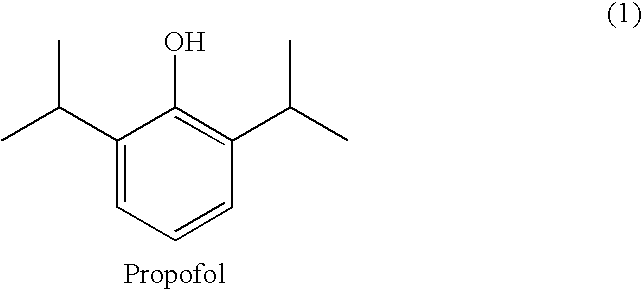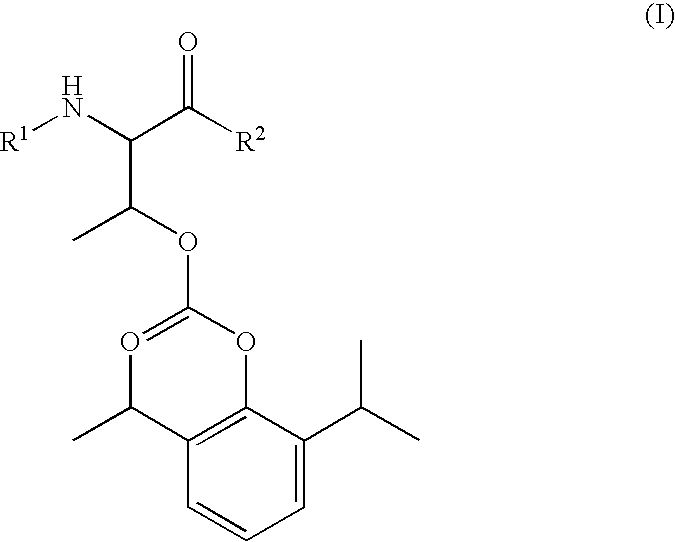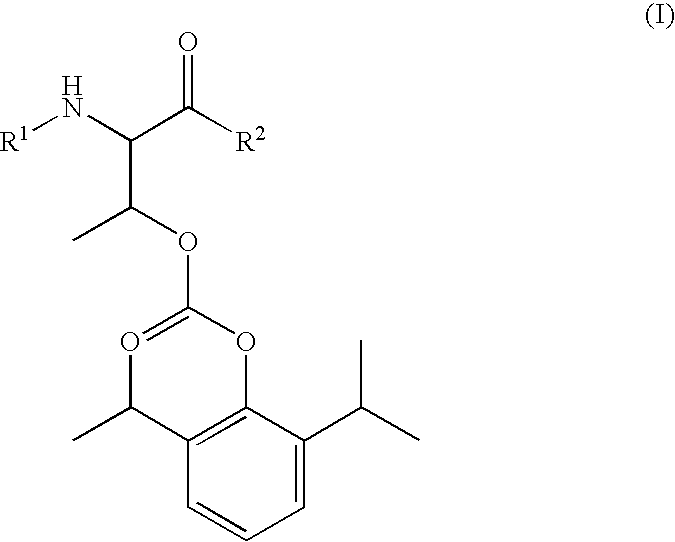Amino acid derived prodrugs of propofol, compositions and uses thereof
a technology of propofol and amino acid, applied in the field of propofol prodrugs, can solve the problems of poor water solubility, discomfort and pain at the injection site, and oral administration has not been considered therapeutically effectiv
- Summary
- Abstract
- Description
- Claims
- Application Information
AI Technical Summary
Benefits of technology
Problems solved by technology
Method used
Image
Examples
example 1
[0180] H-Gly-Thr(γ-OC(O)OPropofol)-OH (10)
STEP A: 2,6-Bis(isopropyl)phenoxycarbonyl chloride (2)
[0181] 20% Phosgene in toluene (139 mL, 0.269 mol) was added to a stirring solution of propofol (40 g, 0.225 mmol) in toluene (80.0 mL) under a nitrogen atmosphere at 0° C. N,N-dimethylaniline (34.0 mL, 0.269 mmol) was added dropwise over 15 minutes. The reaction mixture was allowed to warm to room temperature slowly and stirred for 14 h. The reaction mixture was filtered through Celite and the solvent was removed in vacuo. The crude product was carried to next step without further purification. 1H-NMR (400 MHz, CDCl3): δ 7.29-7.25 (m, 1H), 7.19-7.17 (m, 2H), 3.04-3.01 (m, 2H), 1.25 (d, J=7.2 Hz, 12H).
STEP B: Boc-Thr(γ-OC(O)OPropofol)-OBn (11)
[0182] To an ice cold solution of L-Boc-Thr-OBn (14.1 g, 0.045 mol) in dichloromethane (115 mL) was added propofol chloroformate (2) (14.3 g, 0.059 mmol). To the stirring reaction mixture, diisopropylethylamine (8.74 mL, 0.050 mmol) was added dro...
example 2
[0186] H-Gly-Thr(γ-OC(O)OPropofol)-OH (10)
STEP A: Boc-Gly-Thr-OtBu (14)
[0187] To a nitrogen purged, ice cold solution of Boc-glycine (2.16 g, 0.012 mol) in acetonitrile was added dicyclohexylcarbodiimide (2.80 g, 0.013 mol) and N-hydroxy-succinimide (1.49 g, 0.013 mol). The reaction was allowed to stir for 2 h then was filtered and concentrated in vacuo. The resulting oil was re-dissolved in a 1:1 (v / v) solution of acetonitrile and water and treated with sodium bicarbonate (2.23 g, 0.027 mol) and L-threonine α-t-butyl ester. The resulting mixture was stirred at room temperature for 14 h and then diluted with ethyl acetate (100 mL). The organic solution was washed with 10% aqueous citric acid solution (2×50 mL), saturated aqueous sodium bicarbonate solution (2×50 mL) and brine (2×50 mL). The organic layer was dried over magnesium sulfate and then concentrated in vacuo. The crude compound (14) was used without further purification.
STEP B: Boc-Gly-Thr(γ-OC(O)OPropofol)-OtBu (15)
[01...
example 3
[0190] H-Ala-Thr(γ-OC(O)OPropofol)-OH Hydrochloride (16)
[0191] Following procedures for the preparation of compound (10) and substituting Boc-L-alanine for Boc-glycine (in STEP D of Example 1 or in STEP A of Example 2), adding 1 equivalent of 1N hydrochloric acid in water, and lyophilizing provided the title compound (16). 1H-NMR (400 MHz, CD3OD): δ 7.14-7.22 (m, 3H), 5.47-5.52 (m, 1H), 4.87 (m, 1H), 4.07-4.12 (q, J=14.4 Hz, 1H), 2.91-2.98 (m, 2H), 1.57 (d, J=7.2 Hz, 3H), 1.40 (d, J=6.4 Hz, 3H), 1.17 (dd, J=6.8, 1.6 Hz, 12H). MS (ESI) m / z 395.91 (M+H)+.
PUM
| Property | Measurement | Unit |
|---|---|---|
| pH | aaaaa | aaaaa |
| pH | aaaaa | aaaaa |
| pH | aaaaa | aaaaa |
Abstract
Description
Claims
Application Information
 Login to View More
Login to View More - R&D
- Intellectual Property
- Life Sciences
- Materials
- Tech Scout
- Unparalleled Data Quality
- Higher Quality Content
- 60% Fewer Hallucinations
Browse by: Latest US Patents, China's latest patents, Technical Efficacy Thesaurus, Application Domain, Technology Topic, Popular Technical Reports.
© 2025 PatSnap. All rights reserved.Legal|Privacy policy|Modern Slavery Act Transparency Statement|Sitemap|About US| Contact US: help@patsnap.com



